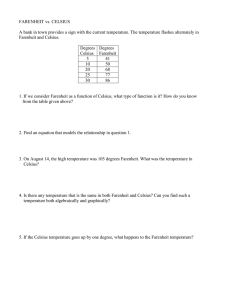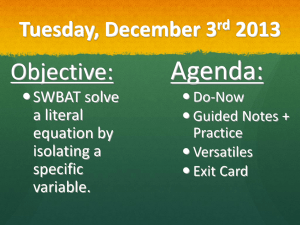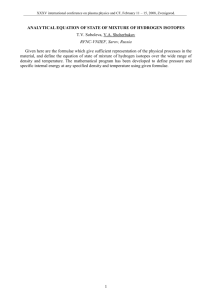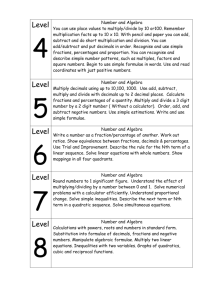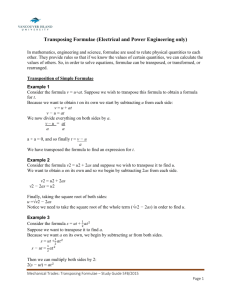Algebra 2
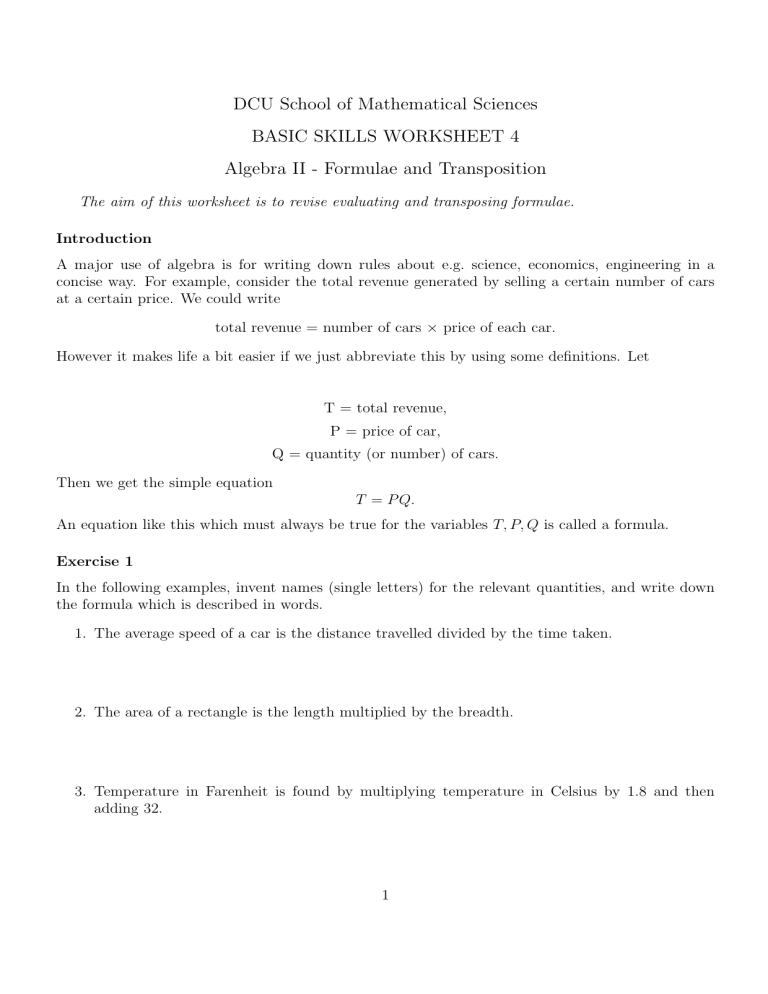
DCU School of Mathematical Sciences
BASIC SKILLS WORKSHEET 4
Algebra II - Formulae and Transposition
The aim of this worksheet is to revise evaluating and transposing formulae.
Introduction
A major use of algebra is for writing down rules about e.g. science, economics, engineering in a concise way. For example, consider the total revenue generated by selling a certain number of cars at a certain price. We could write total revenue = number of cars × price of each car.
However it makes life a bit easier if we just abbreviate this by using some definitions. Let
T = total revenue,
P = price of car,
Q = quantity (or number) of cars.
Then we get the simple equation
T = P Q.
An equation like this which must always be true for the variables T, P, Q is called a formula.
Exercise 1
In the following examples, invent names (single letters) for the relevant quantities, and write down the formula which is described in words.
1. The average speed of a car is the distance travelled divided by the time taken.
2. The area of a rectangle is the length multiplied by the breadth.
3. Temperature in Farenheit is found by multiplying temperature in Celsius by 1.8 and then adding 32.
1
Substituting in formulae
• Making substitutions in formulae allows us to calculate the value of one quantity once the values of all the others are known. For example, the formula s = 4 .
9 t 2 gives the distance s (in meters) which an object falls in t seconds when it is dropped. So after t = 1 second, the object has fallen s = 4 .
9(1) 2 = 4 .
9 metres .
After t = 4 seconds, the object has fallen s = 4 .
9(4) 2 = 4 .
9(16) = 78 .
4 metres .
• Consider the formula r = p x 2 + y 2 .
Evalaute r when x = 5 and y = 12.
r =
√
5 2 + 12 2 =
√
25 + 144 =
√
169 = 13 .
• Consider the formula f = 3 x 2 − 4 x + 6 .
We frequently use the notation f ( x ) = 3 x 2 − 4 x + 6 to emphasise that the formula is telling us how the value of f depends upon the value of x .
We might also write T ( P, Q ) = P Q in the earlier example. If we are using this notation, then f (2) means “the value of the formula when we substitute in x = 2”. So for the example f ( x ) = 3 x 2 − 4 x + 6 we have f (2) = 3(2 2 ) − 4(2) + 6 = 12 − 8 + 6 = 10 , f (1) = 3(1 2 ) − 4(1) + 6 = 3 − 4 + 6 = 5 , f ( − 1) = 3(( − 1) 2 ) − 4( − 1) + 6 = 3 + 4 + 6 = 13 , f ( − 2) = 3(( − 2 2 )) − 4( − 2) + 6 = 12 + 8 + 6 = 26 .
2
Exercise 2
1. Find the value of the unknown quantity in the given formula.
(a) F = 1 .
8 C + 32 Find F when C = 36.
(b) P =
RT
V
Find P when R = 4, T = 275 and V = 22.
(c) s = ut + 1
2 at 2 Find s when a = 9 .
8, u = 3 .
2 and t = 4.
2. Given the formula f ( x ) = − 2 x 2 + 3 x + 6, find
(a) f (1)
(b) f ( − 1)
(c) f (0)
(d) f (2)
(e) f ( − 2).
3
Manipulating formulae
The formula for converting temperature in celsius ( C ) to temperature in Farenheit ( F ) is
F = 1 .
8 C + 32 .
For example, this allows us to convert 15 o Celsius to 59 o Farenheit. But what if we wanted to convert from Farenheit to Celsius? Our present formula tells us immediately the value of F in terms of the value of C . We call it an explicit formula for F . We also say that F is the subject of the formula or that F is expressed in terms of C . What we want to do next is make C the subject of the formula, i.e. get C on its own on one side of the formula. We must manipulate the formula to do this. There is only one rule to follow:
Whatever we do to one side of the equation, we must also do to the other side.
The steps required to do this in the present case are as follows:
F = 1 .
8 C + 32
F − 32 = 1 .
8 C
F − 32
1 .
8
= C start here subtract 32 from both sides divide both sides by 1.8.
This completes the process. We now have our Farenheit-to-Celsius formula where C is expressed in terms of F :
C =
F − 32
1 .
8
.
Manipulating formulae - examples
The rule written down above is the only rule about manipulating formulae. After that, it is a matter of practice. There are some useful guidelines:
• If we want to make x the subject of a formula, try to get all the terms involving x together on one side, with anything not involving x on the other side.
• If x appears in the denominator of a fraction, multiply both sides of the formula by that denominator.
• If there is a square root in the formula, isolate it and then square both sides.
1. Make x the subject of the formula y = − 4 x − 12 .
Solution: y = − 4 x − 12 y + 12 = − 4 x y + 12
− 4
= x start here add 12 to both sides divide both sides by -4
4
2. If T = P Q express Q in terms of T and P .
Solution:
T = P Q
T
= Q
P start here divide both sides by P
There was only one step here. Dividing by P is just like dividing by any other number.
3. Make a the subject of the formula v = u + at .
Solution: v − t v = u + at u v − u
=
= at a start here subtract u from both sides divide both sides by t
4.
4 x + 2 z = yz + 8 y
Express z in terms of x and y .
Solution:
4 x + 2 z = yz + 8 y
4 x + 2 z − yz = 8 y start here subtract yz from both sides
2 z − yz = 8 y − 4 x subtract 4 x from both sides z (2 − y ) = 8 y − 4 x z =
8 y − 4 x
2 − y take z out of both terms on the left-hand side divide both sides by 2 − y
5.
y =
2 x + 3 x − 1
Express x in terms of y
Solution: y =
2 x + 3 x − 1 y ( x − 1) = 2 x + 3 yx − y = 2 x + 3 start here multiply both sides by x − 1 expand yx − y − 2 x = 3 yx − 2 x = 3 + y subtract 2 x from both sides to get all x ’s on the left add y to both sides to get everything not involving x on the right x ( y − 2) = 3 + y x =
3 + y y − 2 take x out of both terms on the left-hand side divide both sides by y − 2 to finish.
5
6. Make b the subject of
Solution: a = 2 r c
.
b a 2 = r a = 2 c
µ b r
2 c b
µr a 2 = 2 2
¶
2 c b
¶ start here
2 square both sides a 2 c
= 4 a 2 b = 4 c b multiply both sides by b b =
4 c a 2 divide both sides by a 2 to finish.
6
Exercise 3
1. Make Q the subject of the equation P = − 3 Q + 35.
2.
v = u + at . Express t in terms of v , u and a .
3.
w =
2 v
. Express v in terms of w .
3
7
4. Make x the subject of the equation y =
2 x + 1
.
x + 4
5.
a =
3 b − 1
2 b + 5
. Express b in terms of a .
6. Make s the subject of the equation t = 3 r s s + 1
.
8
7. Make x the subject of the equation v = √ x
8. Make x the subject of the formula y 2 = 4 − x 2 .
9.
v 2 = u 2 + 2 as Express u in terms of v , a and s .
9
Solutions to exercises
Exercise 1
1. Let s =average speed, d =distance travelled, t =time taken. Then s = d t
.
2. Let A =area, x =length, y =breadth. Then A = xy .
3. Let C = temperature in Celsius, F = temperature in Farenheit. Then F = 1 .
8 C + 32.
Exercise 2
1. (a) 96.8
(b) 50
(c) 91.2
2. (a) 7
(b) 1
(c) 6
(d) 4
(e) -8
Exercise 3
1.
Q =
35 − P
3
2.
t = v − u a
3.
v =
3 w
2
4.
x =
1 − 4 y y − 2
5.
b =
1 + 5 a
3 − 2 a
6.
s = t 2
9 − t 2 k 2
7.
x =
8.
x =
9.
u = v 2 p
4 − y 2
√ v 2 − 2 as .
10
